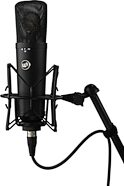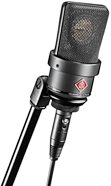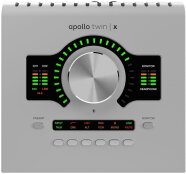Joemeek TwinQ Studio Channel Strip
No longer available at zZounds




zZounds Gear Experts Say...
Amplify, compress, and equalize microphones and instruments before you record with this easy-to-use channel strip from Joemeek.
Overview
The Joemeek twinQ is like having two channels of a professional recording studio in one box. It takes microphones or instruments, amplifies them, compresses and equalizes them ready to be recorded. Simple to use yet extremely powerful, the twinQ will bring out the best in any microphone or instrument and give the gloss of a professional studio production to all your performances. As well as recording it will also be found useful for live work.
The Joemeek Digital Interface has highly stable onboard master clocks for low-jitter, hi-fi results. Internal sample rates of 44.1kHz, 48kHz, 88.2kHz or 96kHz are selected by means of rear panel switches. 44.1kHz is the standard used for audio CD's, while 48kHz and 96kHz are widely used in recording studios. In general, the higher the sample rate, the better the audio fidelity, but the more disk space is required for the recording. For example, recording at 96kHz requires twice as much storage as 48kHz. Consult the manual of your recorder or DAW as to what sample rates it will accommodate.
Alternatively the twinQ… read more may be set to the frequency of an external master word clock, generated, for example, by the studio's recorder or DAW. When connected to the BNC socket provided, a suitable external word clock will be detected automatically and will override the twinQ's internal word clock.
The front panel LED labeled 'EXT CLK' illuminates when the twinQ is successfully locked to an external word clock. To avoid distortion, care should be taken not to overdrive the input to the Digital Interface. The red LED next to the Output Gain control is labeled "PEAK FSD" which stands for "Full Scale Digital". Occasional flashes are OK but if it is on all the time, turn something down! read less
Digital Interface
The Joemeek Digital Audio Interface provides high quality digital audio outputs plus the ability to synchronize to an external word clock. The digital audio outputs are compatible with most digital recorders, as well as Digital Audio Workstations and mixers. S/PDIF format is available from the coaxial and RCA phono connectors, while the transformer coupled XLR connector provides an AES3 compatible output.The Joemeek Digital Interface has highly stable onboard master clocks for low-jitter, hi-fi results. Internal sample rates of 44.1kHz, 48kHz, 88.2kHz or 96kHz are selected by means of rear panel switches. 44.1kHz is the standard used for audio CD's, while 48kHz and 96kHz are widely used in recording studios. In general, the higher the sample rate, the better the audio fidelity, but the more disk space is required for the recording. For example, recording at 96kHz requires twice as much storage as 48kHz. Consult the manual of your recorder or DAW as to what sample rates it will accommodate.
Alternatively the twinQ… read more may be set to the frequency of an external master word clock, generated, for example, by the studio's recorder or DAW. When connected to the BNC socket provided, a suitable external word clock will be detected automatically and will override the twinQ's internal word clock.
The front panel LED labeled 'EXT CLK' illuminates when the twinQ is successfully locked to an external word clock. To avoid distortion, care should be taken not to overdrive the input to the Digital Interface. The red LED next to the Output Gain control is labeled "PEAK FSD" which stands for "Full Scale Digital". Occasional flashes are OK but if it is on all the time, turn something down! read less
Specs
Input impedances:
Mic: 1.2kohm
Line: 20kohm
Pre-amp overall gain: 0dB to 60dB
Common mode rejection: 70dB
Equivalent input noise: -128.5dBu (unweighted)
Distortion: 0.001% (below Compressor threshold)
Frequency response: 10Hz to 70kHz (-3dB)
Maximum input before clipping:
Mic: +21dBu
Line: +45dBu
Headroom before clipping: +21dBu
Compressor threshold: -6dBu to +22dBu (variable)
Compressor ratio: 1:1 to 10:1 (variable)
Compressor attack time: 1 msec to 100 msec (adaptive)
Compressor release time: 0.1 sec to 3 sec (adaptive)
Nominal output levels: +4dBu/-10dBv
Output impedance: 75ohm
Output Level switch: 12dB attenuation
Noise Floor: -85dBu (typical, with ~40dB mic gain)
VU Meter: Analogue movement
Power supply: 115V / 230V ac mains, 50/60Hz
Power consumption: 30W
Mechanical: 482W x 88H x 220D (overall)
Weight: 3 kilos
High Pass Filter: 12dB per octave cut below 80Hz
EQ Boost & Cut: +/-15dB (zero phase-shift bell response)
LF Frequency: 40Hz to 650Hz variable
MID Frequency: 300Hz to 5kHz variable
HF Frequency: 6kHz/12kHz switchable
Digital Output Specifications
Sampling: 24 Bit
Sampling Rate: 44.1kHz, 48kHz, 88.2kHz or 96kHz selectable
Output Formats: XLR AES/EBU, coaxial S/PDIF digital out
External Word Clock input: 75ohm, 1.25V - TTL level, 44.1kHz to 96kHz (auto synchronising)
Mic: 1.2kohm
Line: 20kohm
Pre-amp overall gain: 0dB to 60dB
Common mode rejection: 70dB
Equivalent input noise: -128.5dBu (unweighted)
Distortion: 0.001% (below Compressor threshold)
Frequency response: 10Hz to 70kHz (-3dB)
Maximum input before clipping:
Mic: +21dBu
Line: +45dBu
Headroom before clipping: +21dBu
Compressor threshold: -6dBu to +22dBu (variable)
Compressor ratio: 1:1 to 10:1 (variable)
Compressor attack time: 1 msec to 100 msec (adaptive)
Compressor release time: 0.1 sec to 3 sec (adaptive)
Nominal output levels: +4dBu/-10dBv
Output impedance: 75ohm
Output Level switch: 12dB attenuation
Noise Floor: -85dBu (typical, with ~40dB mic gain)
VU Meter: Analogue movement
Power supply: 115V / 230V ac mains, 50/60Hz
Power consumption: 30W
Mechanical: 482W x 88H x 220D (overall)
Weight: 3 kilos
High Pass Filter: 12dB per octave cut below 80Hz
EQ Boost & Cut: +/-15dB (zero phase-shift bell response)
LF Frequency: 40Hz to 650Hz variable
MID Frequency: 300Hz to 5kHz variable
HF Frequency: 6kHz/12kHz switchable
Digital Output Specifications
Sampling: 24 Bit
Sampling Rate: 44.1kHz, 48kHz, 88.2kHz or 96kHz selectable
Output Formats: XLR AES/EBU, coaxial S/PDIF digital out
External Word Clock input: 75ohm, 1.25V - TTL level, 44.1kHz to 96kHz (auto synchronising)
Reviews
Reviewers gave this product an overall rating of 5 out of 5 stars.
(37 ratings)
Submitted April 27, 2010 by a customer from free.fr
"Awesome stereo channel strip for budget minded tone freaks."
This review has been selected by our experts as particularly helpful.
I've had this for years now, and I've bought more Meek ( a OneQ ), and also a UA LA610mKII ( because I could, and because I wanted a tube pre in my studio, not because the JoeMeek stuff missed anything for my needs : you sometimes, we just want stuff ). It's heads and shoulders above average mixing board channel strips, and on par with high-end strips that retail for a lot more money.
Sound
Very high quality sound if you know how to set levels and use EQ and compression.
Features
A very complete stereo preamplifier. It's actually 2 pres in one as the Iron switch redefines the general preamp tone and adds punch and color. Very clean with the Iron switch off, very thick and colored with the Iron switch on... The rest of the machine is equally impressive with a great sounding EQ, a very effective compressor, and an insert per channel, as well as line imputs... the onboard convertors are really good too, so you can feed you audio interface with converted audio via TOS link or Spdif...
Ease of Use
It's not rocket science, and the pre sounds great. Just set the levels right and dial to taste.
Quality
I've had mine for years, and I have yet to experience a single glitch. No scratchy pot, not failure whatsoever.
Value
Sounds just as good as unit costing 3 times as much. Great great value.
Manufacturer Support… read more
Talked to Allan on the PMI forum : very nice, helpful person.
The Wow Factor
This is highly under-rated as a preamplifier, and should be considered before spending anymore money that this costs. I also own a UA LA610mKII and consider the JoeMeek unit in the same league. It's solid, looks good, but most of all sounds absolutely great.
Musical Background:
pro recording musician
Musical Style:
rock read less
Sound
Very high quality sound if you know how to set levels and use EQ and compression.
Features
A very complete stereo preamplifier. It's actually 2 pres in one as the Iron switch redefines the general preamp tone and adds punch and color. Very clean with the Iron switch off, very thick and colored with the Iron switch on... The rest of the machine is equally impressive with a great sounding EQ, a very effective compressor, and an insert per channel, as well as line imputs... the onboard convertors are really good too, so you can feed you audio interface with converted audio via TOS link or Spdif...
Ease of Use
It's not rocket science, and the pre sounds great. Just set the levels right and dial to taste.
Quality
I've had mine for years, and I have yet to experience a single glitch. No scratchy pot, not failure whatsoever.
Value
Sounds just as good as unit costing 3 times as much. Great great value.
Manufacturer Support… read more
Talked to Allan on the PMI forum : very nice, helpful person.
The Wow Factor
This is highly under-rated as a preamplifier, and should be considered before spending anymore money that this costs. I also own a UA LA610mKII and consider the JoeMeek unit in the same league. It's solid, looks good, but most of all sounds absolutely great.
Musical Background:
pro recording musician
Musical Style:
rock read less
17 of 18 people (94%) people found this review helpful. Did you?
Thanks for your opinion!
No longer available at zZounds
In most cases, a product is unavailable because it has been discontinued by the manufacturer
This is a carousel with product cards. Use the previous and next buttons to navigate.











